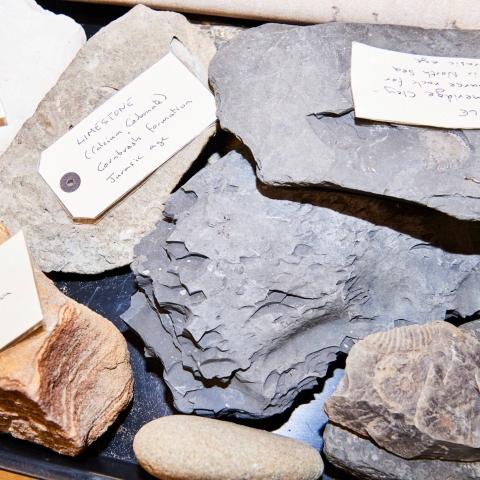
Earth and Environmental Sciences research is the study of our planet and the evolution of life, from its earliest beginnings to the present day. With the future of our planet under threat from environmental crises such as climate change, our research is exploring how the Earth has changed over time. We're using our findings to predict how it may change in the future and what we can do to protect it.
Our Earth and Environmental Sciences areas of expertise
Find out more about our research – and learn more about our recent projects, the academic and industrial partners with whom we collaborate, and the major funders who fund our work.
Palaeontology and Environmental Change Research Group
We're exploring how fossil records can help us understand past climates and environments, and effectively predict and model climate change and its impact on the Earth’s ecosystems.

Environmental Processes and Impacts Research Group
We're looking at the Earth's changing environment and the influence of human activity on climate and ecosystems.

Interested in a PhD in Earth and Environmental Sciences?
Explore our Earth and Environmental Sciences postgraduate research degrees – including PhDs and MPhils.
Our Earth and Environmental Sciences research groups
Ecology and Evolution Research Group
We're expanding knowledge of the diversity of the living world, from molecules to ecosystems, and creating a basis for assessing and reversing the extinction of species.

Crustal Evolution and Tectonics Research Group
We're addressing fundamental questions about the Earth's systems, such as when plate tectonics began operating and how changes in the style and rate of plate movement can be documented through time.

Centre for Applied Geosciences
At the Centre for Applied Geosciences, we're investigating natural and manmade hazards and geo-heritage conservation.

Project highlights
Chernobyl
Our work exploring the impacts of the 1986 nuclear disaster in Chernobyl has shown, for the first time, that wild mammals are thriving in the area abandoned after the accident. Our research proves that human habitation and exploitation is worse for the natural ecosystem than the radiation created by the world’s worst nuclear accident. We're also working with communities in contaminated areas to safely bring abandoned agricultural land back into use, to support economic recovery and development.
Simex Series
We developed Simex Series, the world’s largest simulated disaster and emergency response exercise, in collaboration with Hampshire Fire and Rescue, RedR, an international organisation that helps NGOs respond to humanitarian crises, and L2S2, a company that develops technology to treat disaster victims. The exercise is reducing risk and improving communication during natural disasters, and improving rapid responses to events such as tsunamis, volcanic eruptions, floods, landslides and hurricanes.
Chemcatcher
Our environmental monitoring research led to the development and production of Chemcatcher, a passive sampling device for monitoring pollutants in aquatic environments. Chemcatcher is used by many water companies, including Southern Water, to monitor water quality.
Recent media coverage
-
Professor Jim Smith's work on the return of thriving mammals to Chernobyl, covered by Nature, Forbes, IFL Science and The Times
-
Dr Carmen Solana's research into volcanic hazards and risks, covered by Reuters, Yahoo and the Mail on Sunday
-
University of Portsmouth PhD student Emily Roberts discovers a remarkable new treasure – the first fossil plant gum on record
Facilities
We use the following facilities:
- Geochemical facilities, which include laser ablation and solution ICP-MS and ICP-MC-MS. These allow us to analyse a large range of materials and elements across the periodic table, measure isotope ratios for sourcing of materials and dating minerals
- Imaging facilities, including scanning electron microscopy and near infrared spectroscopy, which allow us to image materials to extremely high magnification, measure the chemistry and crystallography of materials down to the nanometre scale, characterise the spectra of materials, and use remote sensing techniques to map their spatial distribution in the natural environment.
- Rock and soil mechanics, including triaxial and uniaxial presses, acoustic emission sensors, and heating and cooling elements. These allow us to provide data on the physical properties and behaviour of materials under different loading conditions and over a range of conditions.
- Our Hyperspectral Laboratory, which has an ASD Labspec4 (Vis-NIR) spectrometer and a range of spectral imaging systems including an infrared geotechnical core-scanner to examine rocks, soils, debris, environmental materials and archaeological artefacts for engineering and hazard characterisation.
